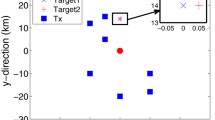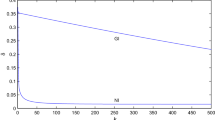Abstract
In wide-area surveillance radar systems, ground moving target indication is the main task. The underlying mathematical problem is to decompose a complex matrix into a low rank matrix and a structured sparse matrix. In this paper, we show that such decomposition has a unique solution under reasonable assumptions. We propose a phase-based model to fully describe the special sparse structure. An alternating direction method of multipliers is implemented to solve the resulting nonconvex complex matrix problem. Simulation results verify the superior efficiency and the improvement of the new model.








Similar content being viewed by others
References
Brenner, A.R., Ender, J.H.G.: Demonstration of advanced reconnaissance techniques with the airborne sar/gmti sensor pamir. Proc. Inst. Elect. Eng. Radar Sonar Navig. 153(2), 152–162 (2006)
Cerutti-Maori, D., Klare, J., Brenner, A.R., Ender, J.H.G.: Wide-area traffic monitoring with the sar/gmti system pamir. IEEE Trans. Geosci. Remote Sens. 46(10), 3019–3030 (2008)
Cerutti-Maori, D., Bürger, W., Ender, J.H.G., Brenner, A.R.: Wide area surveillance of moving targets with the sar/gmti system pamir. In: Proceedings EUSAR (May 2006)
Cerutti-Maori, D., Bürger, W., Ender, J.H.G., Brenner, A.R.: Experimental results of ground moving target detection achieved with the multi-channel sar/gmti system pamir. J. Eur. Microw. Assoc 2, 122–127 (2006)
Cerutti-Maori, D., Gierull, C.H., Ender, J.H.G.: Experimental verification of sar-gmti improvement through antenna switching. IEEE Trans. Geosci. Remote Sens. 48(4), 2066–2075 (2010)
Entzminger, J.N., Fowler, C.A., Kenneally, W.J.: Jointstars and gmti: past, present and future. IEEE Trans. Aerosp. Electron. Syst. 35(2), 748–761 (1999)
Ward, J.: Space–time adaptive processing for airborne radar. Lexington, MA (1994)
Yan, H., Wang, R., Li, F., Deng, Y.: Ground moving target extraction in a multichannel wide-area surveillance sar/gmti system via the relaxed pcp. IEEE Geosci. Remote Sens. Lett. 10(3), 617–621 (2013)
Yan, H., Li, F., Wang, R., Zheng, M., Gao, C., Deng, Y.: Moving targets extraction in multichannel wide-area surveillance system by exploiting sparse phase matrix. IET Radar Sonar Navig. 6, 913–920 (2012)
Li, Q., Yan, H., Wu, L., Wang, R.: Robust PCA for ground moving target indication in wide-area surveillance radar system. J. Oper. Res. Soc. China 1, 135–153 (2013)
Candès, E., Li, X., Ma, Y., Wright, J.: Robust principal component analysis?: Recovering low-rank matrices from sparse errors. IEEE Sens. Array Multichannel Signal Process. Workshop 8(1), 201–204 (2010)
Zhou, Z., Li, X., Wright, J., Candès, E., Ma, Y.: Stable principal component pursuit. In: IEEE International Symposium on Information Theory Proceedings, pp. 1518–1522 (2010)
Lin, Z., Ma, Y., Wright, J.: Low-rank matrix recovery. ICIP Tutorials, Microsoft Research Asia (2010)
Ganesh, A., Wright, J., Li, X., Candès, E.J., Ma, Y.: Dense error correction for low-rank matrices via principal component pursuit. In: IEEE International Symposium on Information Theory Proceedings, pp. 1513–1517 (2010)
Acknowledgements
The first author’s research was supported by the National Science Foundation of China (No. 11671036).
Author information
Authors and Affiliations
Corresponding author
Additional information
Communicated by Jyh-Horng Chou.
Appendix
Appendix
Proof of Theorem 2.2
First, we consider \(n = 3\). For the sake of deriving a contradiction, suppose there exists another nontrivial decomposition \(({\widetilde{C}} ,{\widetilde{T}} ) \) which satisfies \(({\widetilde{C}} ,{\widetilde{T}} )\ne ( C , T )\). Assume they take the following form
where \(v_1,v_2\in \mathbb {C}\) and \(r,t>0\). Assume \(\theta ,\phi \in [0,2\pi [\) and \(\alpha ,\beta \in ]0,2\pi [.\) By \( C + T ={\widetilde{C}} +{\widetilde{T}} \), we have \(v_1+z_j = v_2 + y_j,\ j= 1,2,3\). Let \(v=v_1-v_2\). There is \( z_j+v =y_j,\ j= 1,2,3\). The problem is simplified to find a complex number \(v\in \mathbb {C}\) and a phase \(\beta \in ]0,2\pi [\) such that the following holds
The proof below is geometrically illustrated in Fig. 9. Let \(l_1\) be the bisector of the angle formed by \(z_1\) and \(z_2\). Let \(l_2\) be the bisector of the angle formed by \(z_2\) and \(z_3\). By Lemma 2.1, every v satisfying \(|z_1+v| = |z_2+v|\) belongs to line \(l_1\). Similarly, every v satisfying \(|z_2+v| = |z_3+v|\) lies in line \(l_2\). As a result, every v satisfying both conditions must lie in the intersection of \(l_1\) and \(l_2\).
If the phase difference \(\alpha \in ]0,\pi [\) or \(\alpha \in ]\pi , 2\pi [\) (see Fig. 9a), then we obtain \(l_1\bigcap l_2=\{0\}\). The solution of the first condition in (16) could only be the origin. It follows that another nontrivial solution \(({\widetilde{C}} ,{\widetilde{T}} )\) does not exist. If \(\alpha = \pi \), then \( l_1\) coincides with \(l_2\), i.e., \(l_1=l_2\). It implies that any v in \(l_1\) satisfies the modulus constraints. Then T must take the form \(T= (z_1,-z_1, z_1)\). Without loss of generality, suppose \(\theta = 0\), i.e., \(z_1 = r>0\). According to Lemma 2.1, \(v=p \cdot i\) and \(p\in \mathbb {R}\), \(p\ne 0\) (see Fig. 9b). The phase constraints in (16) yield
Multiplying the second equation by \(e^{i\beta }\) and substituting it into the first equation, we obtain \( -r+p\cdot i = (-r+p\cdot i)e^{i2\beta }\). Then \(\beta =\pi \). Together with \(-r+p\cdot i = -(a+p\cdot i)e^{i\beta }\), one has \(p=0\). This contradicts with the assumption that \(p\ne 0\). In other words, there is no such \((v, \beta )\) that satisfies (16) with \(v\ne 0\) and \( \beta \in ]0,2\pi [\). It follows that the structure decomposition is unique.
For \(n\ge 4\), there are more constraints besides (16). The unique decomposition is then implied by the case of \(n=3\). The proof is finished.\(\square \)
Rights and permissions
About this article
Cite this article
Li, Q., He, L., Qi, L. et al. Unique Decomposition and a New Model for the Ground Moving Target Indication Problem. J Optim Theory Appl 173, 297–312 (2017). https://doi.org/10.1007/s10957-016-1052-5
Received:
Accepted:
Published:
Issue Date:
DOI: https://doi.org/10.1007/s10957-016-1052-5
Keywords
- Ground moving target indication
- Alternating direction method
- Surveillance radar system
- Robust principal component analysis





